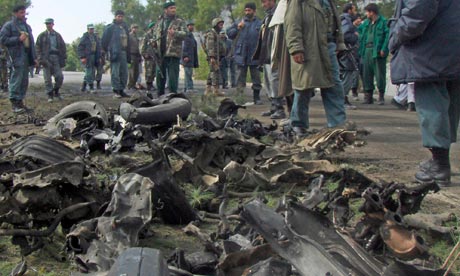War logs show how marines gave cleaned up accounts of incident in which they killed 19 civilians

The site of a suicide bomb which was followed by civilian deaths as US marines escaped.
Brevity is the hallmark of military reporting, but even by those standards the description of one disastrous event is remarkably short: “The patrol returned to base.”
It started with a suicide bomb. On 4 March 2007 a convoy of US marines, who arrived in Afghanistan three weeks earlier, were hit by an explosives-rigged minivan outside the city of Jalalabad.
The marines made a frenzied escape, opening fire with automatic weapons as they tore down a six-mile stretch of highway, hitting almost anyone in their way – teenage girls in fields, motorists in their cars, old men as they walked along the road. Nineteen unarmed civilians were killed and 50 wounded.
None of this, however, was captured in the initial military account, written by the marines themselves. It simply says that, simultaneous to the suicide explosion, “the patrol received small arms fire from three directions”.
And the subsequent rampage as they drove away – which would later be the subject of a 17-day military inquiry and a 12,000-page report – is captured in five words: “The patrol returned to JAF [Jalalabad air field].”
The soldiers’ initial concern, it appears, was a wounded marine – their only casualty. Forty-nine minutes after the initial bombing, they requested a “routine medevac” for a private with “shrapnel wounds to the arm”. He was evacuated to safety.
An hour later came the first news of the trail of blood they left behind. A local government official told the marines there were “28 LN WIA”, which in layman’s terms means 28 Afghan civilians had been wounded. This later transpired to be a gross underestimate.
It was not the last one.
Two hours later Americans returned to the scene of the bombing to conduct an “exploitation of the blast site with pictures/grid cords as well as debriefing ANP leadership on scene”. Journalists on the spot gave a more detailed account. They said angry marines tore their cameras from their hands, insisting they delete the pictures they had taken of bullet-pocked vehicles on the roadside. Rahmat Gul, a freelance photographer working for the Associated Press, said two soldiers and a translator came up to him and asked: “Why are you taking pictures? You don’t have permission.” Then they deleted his photographs.
Later, Gul said, one of the soldiers came up to him and raised his arm, as if to hit him. Taqiullah Taqi, a reporter for the private Tolo TV channel, said the Americans told him through a translator: “Delete them, or we will delete you.”
But the Americans could not prevent anger surging through the local community. In those months, as the fighting escalated, concern about careless, trigger-happy Americans was rising in Afghanistan. The previous May, riots had spread across Kabul after a US military truck with faulty brakes careered into traffic, killing one man.
The logs report that nine hours after the shooting, the governor of Nangarhar province appealed to the marines to stay at home. “He did not want more CF [coalition forces] in the area due to public hostility.” At about the same time the Americans stopped issuing internal reports. “Event closed at 1349Z” it read. But that was not the end of the affair.
Demonstrations ran through the streets of Jalalabad over the following days, the logs report, in which protesters broke windows and blocked roads.
A month later, in April 2007, the Afghan Human Rights Commission published a report into the shooting which said the victims included a 16-year-old newlywed girl carrying a bundle of grass and a 75-year-old man walking back from the shops. The report said the marines may have come under fire from one source straight after the suicide bomb but challenged the assertion they suffered a “complex ambush from several directions”.
By then a US army colonel had admitted to the Afghans that the shootings were a “terrible, terrible mistake” and “a stain on our honour”. He paid $2,000 to the families of each victim. The special forces commander in Afghanistan, Major General Francis Kearney, ordered the marines to pull the 120-man company out of the country, an unprecedented step.
But there would be no punishment. The marines, angered by the criticism of their unit by an army commander, held their own inquiry into the shootings and issued their findings a year later. It exonerated the marines. The troops “acted appropriately and in accordance with the rules of engagement … in response to a complex attack,” said Major General Samuel Helland, the commander of marine forces in the Middle East and Afghanistan.
The inquiry lasted 17 days and heard from 50 witnesses, including Afghans who testified by videolink. But it did not hear from the four soldiers who fired their weapons, because they had not been granted immunity from prosecution.
The findings of the court of inquiry, which ran to 12,000 pages, were not released. No criminal charges were brought against any officer, although some did receive an “administrative reprimand”.
As the war logs might have put it: “Event closed”.
Declan Walsh
Monday 26 July 2010 18.08 BST
Source: The Guardian